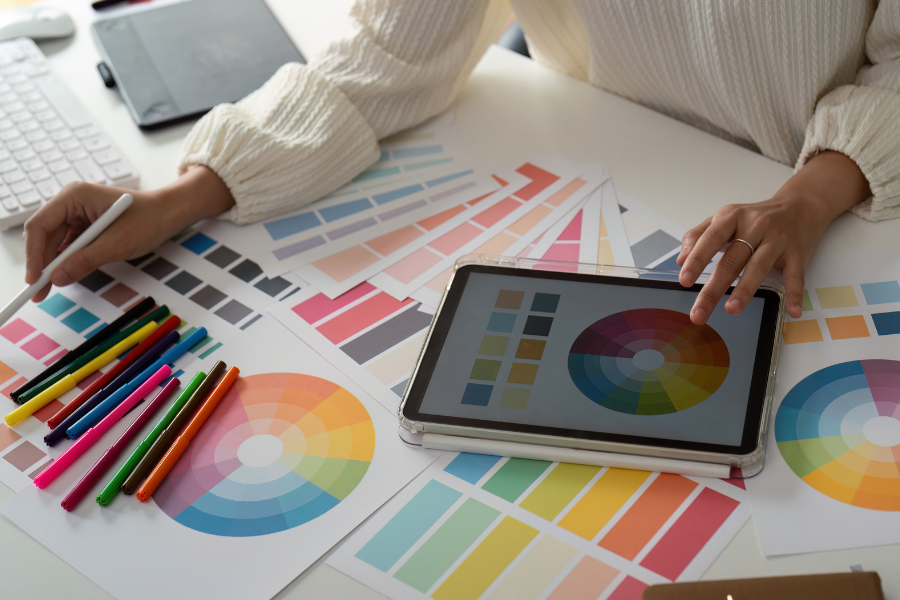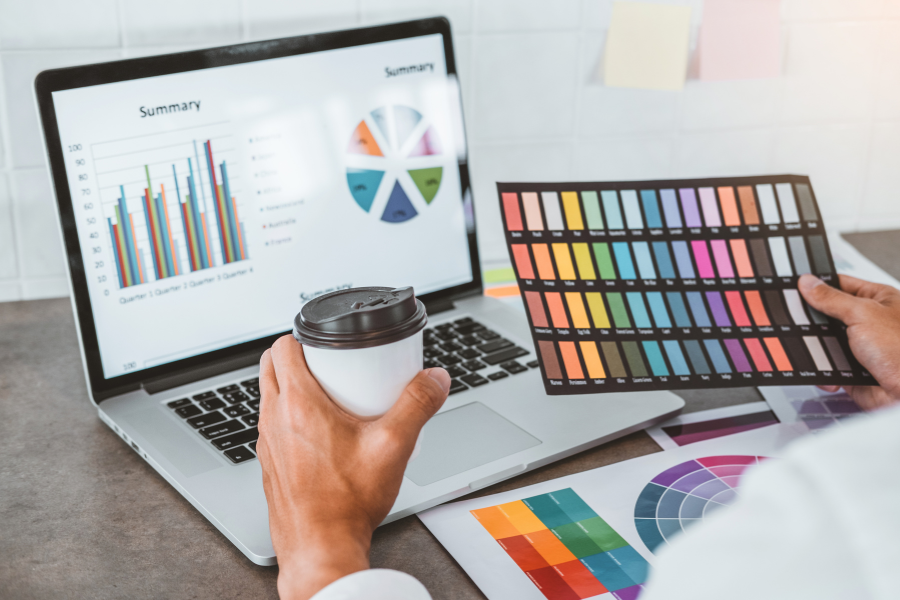Home / Functional Web Design / Web Design / The Role of Color Psychology in Creating High-Converting Websites
Key Takeaways
- The best website color palettes are those that align with your brand identity.
- Use color to guide users’ attention and prioritize critical elements on your website.
- Strategically use color psychology for call to action buttons and other key elements to encourage desired actions.
- Use A/B testing to compare different color schemes and identify what works best for your audience.
- Implementing these strategies can change your website into a lively and high-converting online profile.
Color is an effective tool for influencing our emotions, perceptions, and buying decisions. Each color raise a specific feeling and communicates a message without saying a word. This is why color psychology is so essential in web design.
Color psychology plays an even bigger role on the web. Strategic color choices can make the difference between a website that visitors quickly abandon and one that attracts them, encourages user engagement, and ultimately drives conversions. Creating the best website color palettes is essential for businesses that want to succeed online.
This article will discuss color psychology and explore how you can use its ability to create high-converting websites. We’ll learn the science behind color associations, discover how to choose the perfect website color schemes for conversions and discover techniques to optimize your website’s color scheme for maximum impact.
This guide will equip you with the knowledge and tools to change your website into a lively, engaging, and profitable online presence.
Understanding Color Psychology
A bright yellow room can feel energizing, while a deep blue room might feel calming. But have you ever stopped to consider why? What is it about color that induces such strong emotions and associations? It is the psychology of color, a field that explores how color influences human behavior and decision-making. By understanding these principles, you can use the power of color to create spaces that arouse specific moods and feelings.

The Science Behind Color Psychology
While the full scope of color psychology is complex, the basics are surprisingly simple. It all starts with how our brains process light. When light hits our eyes, it triggers signals that travel to the brain, where they are interpreted as color. But this process isn’t purely physical; it’s also deeply cross with our emotions, memories, and cultural experiences.
Different colors stimulate different brain parts, leading to various physiological and psychological responses. For example, red has been shown to increase heart rate and respiration, while blue can have a calming effect. This is why understanding the psychology of color in marketing and web design is so crucial. Using the best website color palettes can influence how your visitors feel and behave.
Color Associations and Meanings
Over time, we develop strong associations with specific colors. These associations can be personal, based on our individual experiences, or cultural, shaped by our society’s norms and traditions. This is why it’s essential to consider color psychology for user experience, as different people may react differently to the same colors. Here are some common color associations:
- Red – Excitement, passion, energy, danger
- Blue – Trust, security, peace, stability
- Green – Nature, growth, harmony, freshness
- Yellow – Happiness, optimism, warmth, caution
- Purple – Luxury, royalty, creativity, mystery
- Orange – Enthusiasm, creativity, warmth, playfulness
- Black – Sophistication, power, elegance, mystery
- White – Purity, cleanliness, simplicity, innocence
It’s important to note that these associations can vary across cultures. For instance, in some Eastern cultures, white is often associated with mourning, while in Western cultures, it’s typically associated with purity and weddings.
Brands leverage these associations to communicate their identity and values. Think of Coca-Cola’s iconic red, which evokes feelings of excitement and energy, or Tiffany & Co.’s signature blue, which conveys luxury and sophistication. Choosing a suitable website color scheme for your brand can make a big difference in how it’s perceived.
The Impact of Color on Emotions
Colors significantly impact our emotions. They can influence our mood, behavior, and even our decision-making. This is why color psychology in web design is essential for creating high-converting websites. By strategically using colors, you can stimulate specific emotions in your visitors, encouraging them to engage with your content and ultimately take desired actions.
- Warm colors like red, orange, and yellow evoke excitement, energy, and optimism.
- Cool colors like blue, green, and purple are often associated with calmness, tranquility, and security.
By understanding the emotional impact of different colors, you can use them strategically to create a desired atmosphere on your website. For example, a spa website might use calming blues and greens to create a sense of relaxation, while a fitness website might use energetic reds and oranges to motivate visitors.
Applying Color Psychology to Web Design
Knowing how colors influence emotions and perceptions is one thing, but how do you actually apply that knowledge to your web design? It’s time to translate theory into practice and create a website that looks visually appealing and drives conversions. This is where understanding color psychology in web design becomes essential.

Defining Your Brand Identity and Target Audience
Creating a strong brand identity and identifying your target audience are important steps for any business, big or small. These foundational elements will guide your marketing efforts and ensure you connect with the right customers.
- What is the personality of your brand? Is it playful and energetic? Sophisticated and elegant? Trustworthy and reliable?
- Who are you trying to reach with your website? What are their demographics, interests, and preferences?
Your website color schemes for conversions should align with your brand identity and affect your target audience. For example, if you’re a children’s clothing brand, you might choose bright, playful colors that appeal to kids and their parents. On the other hand, if you’re a law firm, you might go for more conservative website color schemes like blue and gray to convey trust and professionalism. Here are some examples of color palettes for different brand archetypes:
- Sophisticated – Black, white, gold, navy
- Playful – Bright colors, pastels, contrasting hues
- Trustworthy – Blue, green, brown, beige
- Creative – Purple, orange, turquoise, unconventional combinations
Remember, the best website color palettes effectively communicate your brand message and appeal to your target audience. This means considering factors like your industry, brand personality, and the emotions you want to bring up in your users. A well-chosen color scheme can create a unified and engaging experience that aligns with visitors and encourages them to explore further.
Creating a Visual Hierarchy with Color
Color is a powerful tool for guiding users’ attention and creating a clear visual hierarchy on your website. Strategically using color can emphasize important elements and guide visitors towards desired actions, which is a key aspect of color psychology for user experience.
- Use contrasting colors to highlight key elements. For example, a bright red call-to-action button will stand out against a neutral background. This is a great way to use color psychology for call-to-action buttons.
- Use color to differentiate sections and guide navigation. Different colors can visually separate different sections of your website, making it easier for users to find what they’re looking for.
- Use color to create a sense of depth and dimension. Lighter and darker shades of the same color can be used to create visual interest and guide the eye.
Using color psychology in web design can improve the usability and effectiveness of your website. You can use colors to guide people’s attention, change their behavior, and make the online experience more interesting and natural if you know how people see them and how they make them feel.
Using Color to Enhance User Experience
Color effectively makes users sense and interact with your website or app. It can influence emotions, guide attention, and even impact user decisions. Color can significantly impact the overall user experience on your website. Therefore, understanding and strategically applying color theory is important for web designers to create visually appealing and user-friendly interfaces.
- Readability – Ensure sufficient contrast between text and background colors for easy reading.
- Navigation – Color highlights menus, links, and other navigational elements.
- Accessibility – Consider users with visual impairments and choose color schemes that meet accessibility standards.
By using color thoughtfully, you can create a website that is visually appealing, user-friendly, and accessible to everyone. This is how you can leverage color psychology for user experience to its fullest potential.
Color Psychology for Different Industries
While general color associations provide a good starting point, industry-specific variations must be considered when choosing website color schemes for conversions. For instance, green might evoke feelings of peace in a wellness brand but signify wealth and security in the financial sector. Therefore, conducting thorough research within your target market is essential to identify the most effective color palette for your website.

- Healthcare – Often uses calming blues and greens to promote a sense of tranquility and well-being.
- Finance – Blues and grays may be used to convey stability and trust.
- E-commerce – Often uses a variety of colors to highlight products and encourage purchases.
Understanding the psychology of color in marketing within your specific industry allows you to make informed color choices that match your target audience. This ensures that your branding and website match their preferences and expectations, promoting a sense of trust and connection. Ultimately, aligning your color palette with your industry and audience can significantly contribute to increased engagement and conversions.
Optimizing Website Color Schemes for Conversions
We’ve explored the psychology of color and how it applies to web design. Now, let’s focus on the ultimate goal of increasing conversions. Whether you want visitors to make a purchase, sign up for a newsletter, or request a quote, strategic use of color can significantly impact your success. Choosing the best website color palettes is essential for achieving your conversion goals.

The Psychology of Call to Action Buttons
Call to action (CTA) buttons are crucial elements on any website. They guide visitors towards desired actions and are vital in driving conversions. But did you know that the color of your CTA buttons can affect their click-through rates? This is why color psychology in web design plays such a crucial role.
Color psychology for call to action buttons is an essential aspect of optimization. Different colors evoke different emotions and associations, influencing whether or not a visitor clicks on a button.
- Red – Creates a sense of urgency and excitement but can also be perceived as aggressive.
- Green – Often associated with growth and positivity, signaling a safe and straightforward action.
- Orange – Conveys enthusiasm and encourages action.
- Blue – Inspires trust and security.
The best color for your CTA button will depend on your overall website color scheme, brand identity, and the specific action you want visitors to take. The goal is to choose a color that stands out from the background, attracts attention, and clearly communicates the button’s purpose to your users.
A/B Testing Color Choices
While general guidelines are helpful, the most effective way to optimize your website color schemes for conversions is through A/B testing. This involves creating two-page versions with different color schemes and comparing their performance.
Analyzing metrics like click-through and conversion rates can help you identify which color scheme performs best for your target audience. A/B testing allows you to make data-driven decisions and continuously improve your website’s effectiveness.
Case Studies
Real-world examples can provide valuable insights into the power of color psychology in web design. Here are a few case studies that demonstrate how strategic color choices can lead to significant improvements in conversions:
- Example 1 – An e-commerce website increased its “Add to Cart” button clicks by 20% by changing the button color from green to red.
- Example 2 – Changing the background color from white to light blue on a landing page increased form submissions by 15%.
These case studies highlight the importance of understanding color psychology and using it to optimize your website’s color scheme for maximum impact. When using color psychology in web design, you can significantly improve your conversion rates.
Color Psychology for Dallas Businesses
While the principles of color psychology in web design are universal, catering to a specific audience can present challenges. For businesses in Dallas, understanding the local culture and preferences can be crucial in creating a website that truly matches with potential customers and encourages conversions.
- Local Insights – When choosing website color schemes for conversions for Dallas businesses, it’s essential to consider these local distinctions.
- Bold and Confident – Dallas has a strong sense of pride and confidence. Don’t avoid using bold colors that reflect this spirit, and remember that color psychology for different industries can play a role here.
- Warm and Welcoming – Southern hospitality is a symbol of Dallas culture. Incorporate warm colors like reds, oranges, and yellows to create a welcoming atmosphere on your website.
- Modern and Stylish – Dallas appreciates style and sophistication. Consider incorporating modern color palettes with clean lines and elegant design elements. Having the best website color palettes can make a difference.
Dallas-Specific Examples
Many successful Dallas businesses effectively utilize color psychology in web design to strengthen their brand identity and connect with their target audience. Businesses should understand the psychological impact of different colors and align them with their brand values.
- Example 1 – A local restaurant uses warm, inviting colors like red and orange to create a sense of energy and excitement, reflecting the lively Dallas dining scene. This demonstrates how color psychology for different industries, such as the food industry, can be used effectively.
- Example 2 – A Dallas tech startup uses cool blues and greens to convey innovation and trustworthiness, appealing to the city’s growing tech community. This showcases how color psychology in web design can be tailored to a specific target audience.
These examples demonstrate how color psychology can be adapted to connect with Dallas’s specific cultural context. They highlight how color psychology can be tailored to resonate with Dallas’s specific cultural context. It’s not just about applying general color associations but understanding how those colors are seen and interpreted within the local culture.
Create High-Converting Websites with Color Psychology
Color is more than just a visual element on your website. It’s a vital tool that impacts user experience, brand perception, and conversions. By understanding the principles of color psychology in web design, you can make informed decisions about your website’s color scheme and create a truly engaging and effective online presence.

Remember that color can arouse specific emotions, influence behavior, and guide user attention. Choosing the right colors can create a sense of harmony and visual appeal, while poorly chosen colors can lead to confusion and disinterest. So, take the time to carefully consider your color palette, ensuring it aligns with your brand identity, target audience, and overall website goals.
Bless Web Designs’ Expertise
Bless Web Designs is a Dallas web design agency that understands the importance of color psychology in creating high-converting websites for local businesses. With years of experience, we deeply understand the local culture and design preferences.
We know how to influence color psychology for user experience and create website color schemes for conversions. By combining our expertise in web design with a keen understanding of color psychology, Bless Web Designs helps Dallas businesses create websites that look attractive and drive results.
Want a website that looks great and gets results? Bless Web Designs is an expert at using color psychology to create websites that people love. Contact us for a free consultation, and let’s discuss how we can make your website attractive.



 Inspired by
Inspired by 




